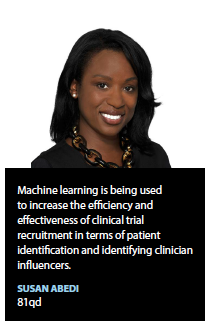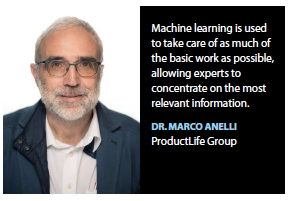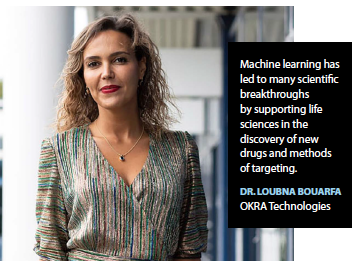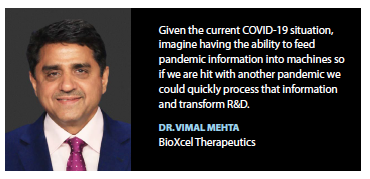Machine learning is being applied across the industry to support decision-making in clinical trials, R&D, regulatory, and commercial processes.
 What’s the difference between machine learning and artificial intelligence? The answer lies in the word intelligence, since AI is about enabling machines to make decisions, whereas machine learning refers to the ability to teach machines to extract information or patterns from data.
What’s the difference between machine learning and artificial intelligence? The answer lies in the word intelligence, since AI is about enabling machines to make decisions, whereas machine learning refers to the ability to teach machines to extract information or patterns from data.
In life sciences, machine learning is being more widely applied to discover patterns hidden in the massive amounts of healthcare data being generated today and to support decision-making, says Basheer Hawwash, Ph.D., principal data scientist, Remarque Systems.
In essence, machines are there to carry out laborious, basic work, leaving researchers and other experts to focus on what is relevant, says Marco Anelli, M.D., head of ProductLife Group’s Information, Knowledge & Intelligence Group.
“Take research for COVID-19 for example, machine learning probably won’t come up with a big discovery but it will sift through thousands of potential molecules and remove those that aren’t relevant so that experts can focus on just those that hold potential," Dr. Anelli says.
According to Vimal Mehta, Ph.D., CEO of BioXcel Therapeutics, machine learning approaches can help unlock potential new uses for drugs in clinical trials or find new therapeutic indications for drugs that previously failed. “Machine learning could also help to speed up processes and provide treatments faster," he says. “Machine learning algorithms could be applied to parse the information about compounds, biochemical pathways, different drug mechanisms, disease pathologies, symptoms, and diseases that can be used to create new relationships by building meta data and then translate that meta data into novel connections, enabling the discovery of therapeutics."
 Machine learning can process both labeled and unlabeled data, Dr. Hawwash says, explaining that labeled data is typically when researchers already know the outcome but want to predict how future data will behave. An example is processing MRI images of cancer to build a prediction model to detect the disease.
Machine learning can process both labeled and unlabeled data, Dr. Hawwash says, explaining that labeled data is typically when researchers already know the outcome but want to predict how future data will behave. An example is processing MRI images of cancer to build a prediction model to detect the disease.
“Algorithms dealing with unlabeled data — raw data that hasn’t been categorized — are incredibly useful for a crisis, such as the COVID-19 pandemic," he says. “We don’t know what the outcome will be, but we try to use all this source data to answer questions that nobody has answered before."
Machine Learning and R&D
Dr. Hawwash says machine learning can be, and is being, used in every stage of drug development, starting with the ability to analyze the DNA of a disease much faster, as well as predict the pharmaceutical properties of a broad range of molecular compounds.
“During the planning and start-up phases, existing literature about similar clinical trials can be fed into a text-mining algorithm to help design a study, data can also be used to facilitate site selection and to quickly and accurately identify patients for trials," he says. “Once the study is in progress, machine learning can support remote monitoring that identifies data risk and patient safety concerns."
Loubna Bouarfa, Ph.D., founder and CEO at OKRA Technologies, says machine learning algorithms have already been used in the design of automated drug development pipelines, guiding, and speeding up drug discovery, preclinical, and clinical studies.
For its acute agitation drug, BioXcel is developing an algorithm to be used with the Apple Watch that potentially predicts when a patient will have an agitation episode, enabling the administration of BXCL501 before the onset of agitation. Agitation can result from multiple disorders, like schizophrenia, bipolar, Alzheimer’s, dementia, opioid withdrawal symptoms, and delirium. BioXcel is currently conducting Phase III trials of BXCL501 for the treatment of acute agitation in patients with schizophrenia and bipolar disorder.
 “The drug was identified using machine learning and AI," Dr. Mehta says. “The whole process is driven by a machine-learning approach. We hope we can validate the model by filing our first NDA in 2021, and upon approval, go to market in early 2022."
“The drug was identified using machine learning and AI," Dr. Mehta says. “The whole process is driven by a machine-learning approach. We hope we can validate the model by filing our first NDA in 2021, and upon approval, go to market in early 2022."
Susan Abedi, executive VP, commercial solutions at 81qd, says machine learning is being used to improve clinical trial recruitment in different ways. One way is by identifying healthcare professionals who are highly likely to encounter target patients with rare diseases, enabling companies to more effectively carry out trial recruitment.
“Machine learning can identify influential clinicians who are connected to other clinicians managing relevant patients," Ms. Abedi says. “Biopharmaceutical companies can partner with clinical leaders to serve as investigators for trials and clinical leaders can leverage their networks to drive clinical trial recruitment of eligible patients through referrals."
“Machine learning replaces the mundane tasks of scrolling through literature and clinical trial results," Dr. Bouarfa says. “In terms of the conduct of clinical trials, machine learning can be deployed in every single step of protocol design, such as background information, objectives and evaluation criteria, subject selection, study procedures, or power calculation, among others."
Researchers can also apply machine learning to determine whether a drug is carcinogenic or not, Dr. Anelli says.
“Through machine learning we can get an accurate idea as to whether a drug is dangerous — this is a valid and validated approach," he says. “This is a use of machine learning that is being applied quite extensively. It’s important since it allows researchers to filter out many drugs, saving years in time and millions of dollars. This approach also prevents the need to kill vast numbers of lab animals in toxicology studies."
Other important uses of machine learning include drug optimization and drug repurposing, Dr. Anelli adds.
“COVID-19 has brought drug repurposing to the fore, with significant research into different marketed drugs as potential treatments for the virus," he says. “Existing drugs are being examined by means of machine learning algorithms to determine if they can be successfully repurposed to prevent the lung and organ damage caused by the virus."
Machine learning also potentially enables studies to enroll fewer patients, which could speed up the enrollment process, be less costly, and reduce the risk to patients, Dr. Anelli says. The process has been used to improve the efficiency of the statistical analysis of clinical trials, and it has huge potential to aid precision medicine, he notes.
“When collecting thousands of variables for thousands of patients, the result is billions of potential correlations," Dr. Anelli says. “If the goal is to correlate each of these parameters with each of the others to determine the effectiveness of a drug on a group of people based on their genes, sex, and so on, then it’s something that can effectively be done using a machine learning-based approach."
 Dr. Bouarfa says by combining data from demographics, pre-existing conditions, lab tests, imaging, -omics, and wearables, machine learning could identify characteristics of patients most likely to benefit from treatment. Furthermore, the historical data could be used to predict the sample size, recruitment times, and dropout rates for future trials.
Dr. Bouarfa says by combining data from demographics, pre-existing conditions, lab tests, imaging, -omics, and wearables, machine learning could identify characteristics of patients most likely to benefit from treatment. Furthermore, the historical data could be used to predict the sample size, recruitment times, and dropout rates for future trials.
“For clinical trials, we need a change of mindset, moving away from the classical clinical trial framework and accepting a more adaptive approach," she says.
One area where machine learning is invaluable is in genomics, says Mark Kiel, M.D., Ph.D., co-founder and chief science officer at Genomenon.
“One significant application involves examining data from genome sequencing results on large cohorts of patients annotated with empirical evidence in published literature, and associated databases relevant to the disease of interest," he says.
“In the case of genomics, machine learning techniques are being used to stratify patients into responders and non-responders based on a variety of clinical parameters in an effort to understand the genetic underpinnings of differential drug responses or clinical phenotypes," Dr. Kiel says. “At Genomenon, we aggregate the information for a given disease, phenotype, gene, pathway, or treatment to assemble de novo a comprehensive genomic landscape of all genetic associations, focusing on causative genetic variants. We then prioritize these results by the strength of this associative evidence."
Dr. Kiel says there have been many breakthroughs with the company’s Mastermind Genomic Landscapes to better understand the genetic drivers of disease. These include identifying vastly more pathogenic and likely pathogenic variants for each disease indication than previously known, significantly expanding clinical trial patient population, and gaining novel insight into the mechanism of action for each therapeutic target.
In a first for machine learning, a long-acting potent serotonin 5-HT1A receptor agonist was identified; the compound is currently in Phase I clinical trials for the treatment of patients with obsessive-compulsive disorder.
“By using machine learning, we were able to rapidly sift through algorithms to pinpoint the most effective molecules to engineer the drug," Dr. Hawwash says. “This process accomplished in just a year what typically takes five years. This demonstrates the power of machine learning to help drug development become faster and more efficient — within the decade maybe all new drugs will be created by machine learning."
The Machine Potential
According to Ms. Abedi, machine learning can use a broad range of claims data to fundamentally change how the industry approaches both patients and physicians in a more nuanced and impactful way.
“With patients, machine learning can help accelerate the process of getting the right therapies to the right patients," she says. “For example, patient-finding solutions use predictive analytics and machine learning–based algorithms to examine real-world data to identify patients with difficult-to-diagnose diseases, which can drive earlier treatment."
With regard to physicians, Ms. Abedi says machine learning can help identify clinicians who drive behavior change and who can therefore impact the care of patients well beyond their own practices. She notes that collectively, machine learning-based network mapping and natural language processing can optimize patient care by helping to ensure that therapeutic interventions get to the right patients.
The opportunities to apply machine learning also extend into other parts of the life-sciences business, including regulatory processes.
Machine learning-based approaches are being used to help with regulatory compliance, Dr. Anelli says, citing the IBM Watson initiative that is being used to help organizations set up their compliance in all areas — from the dossier submission to legal regulatory requirements to regulations around production and beyond.
“A good example of where machine learning is highly effective is signal detection, because there is a massive amount of data, and pharmacovigilance departments need to extract the signal from the noise," he says.
Managing the Challenges
Dr. Kiel says with machine learning techniques in general, one of the main challenges is overfitting the data — when a model doesn’t generalize well from training data to subsequent datasets. Problems with overfitting are amplified when the analysis is meant to inform clinical decision-making or the conduct of a clinical trial.
“When applying black-box machine learning techniques to clinical trial design and analysis, the goal is to ensure there is a solid evidence predicate for any decisions that are made as a result of the analysis," he says. “In effect, the path to the result must be clearly defined and understood at the human level by clinicians and investigators, as well as corroborated statistically. Ideally, the results will also be corroborated by some orthogonal analytic technique as well."
Dr. Mehta says with machine learning, access to and use of relevant data are key, as is building the right model for the machine.
Still regulatory concerns can hold companies back from applying machine learning, Dr. Hawwash says. Reservations are understandable, he says, given that machine learning algorithms aren’t static.
“For example, if a clustering algorithm is used to group clinical trial sites, and that grouping is used to determine the frequency of visits, it might later be hard to explain to regulators why a site belonged to a certain cluster," he explains. “However, the advantages machine learning offers are tremendous, and we should be pushing to use it at least as a guideline for decision-making. Fortunately, the industry’s resistance shows signs of loosening given the new medical breakthroughs using machine learning."
The fast-moving nature of machine learning means legislators and regulators are challenged to keep up, Dr. Anelli says.
 “Dr. Phil Tregunno, who oversees vigilance, intelligence, and research at the MHRA, has spoken about the legislative challenges as well as the supervision of machines," Dr. Anelli says. “Dr. Tregunno points out that machines are inherently ‘conservative,’ because in order for them to ‘react’ there has to be a strong signal. He warns if we give too much power to the machine we may end up with a bunch of traditionalists in charge instead of innovation-oriented entities."
“Dr. Phil Tregunno, who oversees vigilance, intelligence, and research at the MHRA, has spoken about the legislative challenges as well as the supervision of machines," Dr. Anelli says. “Dr. Tregunno points out that machines are inherently ‘conservative,’ because in order for them to ‘react’ there has to be a strong signal. He warns if we give too much power to the machine we may end up with a bunch of traditionalists in charge instead of innovation-oriented entities."
Ms. Abedi points out that machine learning must be structured to guide action and not just provide information or there is a risk of analysis paralysis.
“Overthinking in the decision-making process can result in no action at all or delayed action," she says. “In the dynamic world of healthcare, agile marketing demands speedy decision-making based on the best data available at the time."
Another pitfall to avoid is becoming too siloed, Ms. Abedi says, adding that biopharma companies must ensure critical work is carried out across medical, commercial, creative, and data science teams to bridge data insights, define the right questions, structure assessment, and build models that translate outputs into actionable insights.
“Integrating machine learning with clinical expertise and strategy is the linchpin of leveraging data to maximize impact," she says. “Successful analytics teams or partners should be cross-functional translators of data insights."
To mitigate some of the challenges, Dr. Bouarfa says pharmaceutical companies should keep several key considerations in mind. First, have the data environment ready since to train machine learning systems, the data needs to be consistent and aligned to industry standard references. Second, machine learning algorithms should be designed with a focus on the problem to be solved. Third, all internal barriers to adoption, such as the integration of third-party apps, need to be removed. And fourth, machine learning should be used to empower people, not replace them.
Implementing Machine Learning — Cautiously
“Machines don’t get tired, they can read millions of publications and make connections based on the direction of the data," Dr. Mehta says. “By combining machines and drug developers, unique insights emerge that can increase the efficiency of the overall drug development process."
Dr. Mehta says with machine learning, access to and use of relevant data are key, as is building the right model for the machine.
Interest in machine learning and other forms of AI is increasing, Dr. Mehta says, and larger pharma companies have started embracing these platforms. Machine learning requires a different mindset. While drug developers typically have a hypothesis that they want to test, machine learning looks at all of the experiments and integrates that knowledge before determining what’s best from a drug development perspective.
“These approaches are complementary to one another and will help to drive innovation," he says.
Dr. Hawwash says it’s important that attention is paid to vetting and verifying the quality of the input data to make certain that the output is reliable. It’s also important to recognize that most machine-learning algorithms have an inherent randomness, so their outcomes should be considered as guidelines for better decision-making — not as the final arbiter.
Furthermore, machine learning is simply a tool.
“The key consideration in my mind is the need to not rely exclusively on the results of machine learning approaches to drive research or clinical decisions, but rather to have the results of machine learning lead to appropriate confirmatory and empirical down-stream studies," Dr. Kiel says.(PV)
~~~~~~~~~~~~~~~~~~~~~~~~~
Machine Learning and Medical Imaging
Machine learning (ML) and artificial intelligence (AI) technologies are gaining ground in medical imaging. For many health IT leaders, machine learning is a welcome tool to help manage the growing volume of digital images, reduce diagnostic errors, and enhance patient care. Despite its benefits, some radiologists are concerned that this technology will diminish their role, as algorithms start to take a more active part in the image interpretation process while ingesting volumes of data far beyond what any human can do.
ML — and CAD applications in general — show promise, and radiologists have much to gain from incorporating this technology into their operations:
AI can evaluate an enormous number of imaging variables much faster, and more consistently, than a radiologist.
Algorithms facilitate decision-making and education for inexperienced radiologists.
CAD can automate mundane reading and measurement tasks, freeing radiologists to focus on patient interaction, research, and complex higher-order thinking.
ML can automate radiologist workflow, placing more time-sensitive cases higher on the radiologist’s worklist.
 Machines have the potential to improve diagnostic accuracy dramatically, prevent medical errors, and reduce the overuse of testing.
Machines have the potential to improve diagnostic accuracy dramatically, prevent medical errors, and reduce the overuse of testing.
ML can act as a next-generation clinical decision support tool for radiologists, offering segmentation, classification, and pattern recognition that can be used to propose statistically significant guidance for image analysis.
Analyzing images can be highly subjective; machines replace subjectivity and reader variability with quantitative measurements that can improve patient outcomes.
There are, nevertheless, many challenges, such as concerns among radiologists that ML will lead to fewer jobs and a diminished role, possible legal challenges if an algorithm leads to errors or misdiagnosis, and the sheer complexities involved in building algorithms that apply to a broad set of scenarios. To mitigate some of these issues, ML implementations should look at several key considerations:
Engage all stakeholders in the planning process. ML can help radiologists improve patient outcomes, but ML initiatives can fail if healthcare organizations do not address fears.
Be mindful of the application scope. Many ML algorithms are narrow in their application, working across select modalities to inform decisions on specific diseases.
Incorporate ML as a complement to the radiology staff. Even when algorithms are accurate, radiologists still need to apply their judgment, using the algorithm as a secondary support system to optimize care.
~~~~~~~~~~~~~~~~~~~~~~~~~
Machine Learning: Preventing Theft
A potential for machine learning is training software to recognize known patterns of drug thefts in healthcare facilities, commonly called drug diversion.
“When we began leveraging machine learning, we compiled a large database of known drug diversion cases where individuals had been stealing drugs, including data from various health IT systems," says Tom Knight, CEO of Invistics. “We programmed our software to recognize these events as potential indicators of drug diversion. The more information we provided, the easier it became for our software to comb through similar data from other facilities and detect incidents that exhibit the same patterns that have already been linked with drug diversion."
When developing a solution to aid in the detection of drug diversions, Mr. Knight says one challenge is to join all of the databases from a variety of different health IT systems — not just EMRs or ADCs — but also purchasing records, payroll, and attendance systems, and a variety of other inventory management systems.
“Another issue that is top-of-mind is improving accuracy so the system alerts for as few false positives and false negatives as possible," he says. “Machine learning has significant benefits here as it learns from mistakes, as well as proven incidents of diversion. Every false positive and false negative provides data and improves the accuracy of the machine-learning algorithms."

















